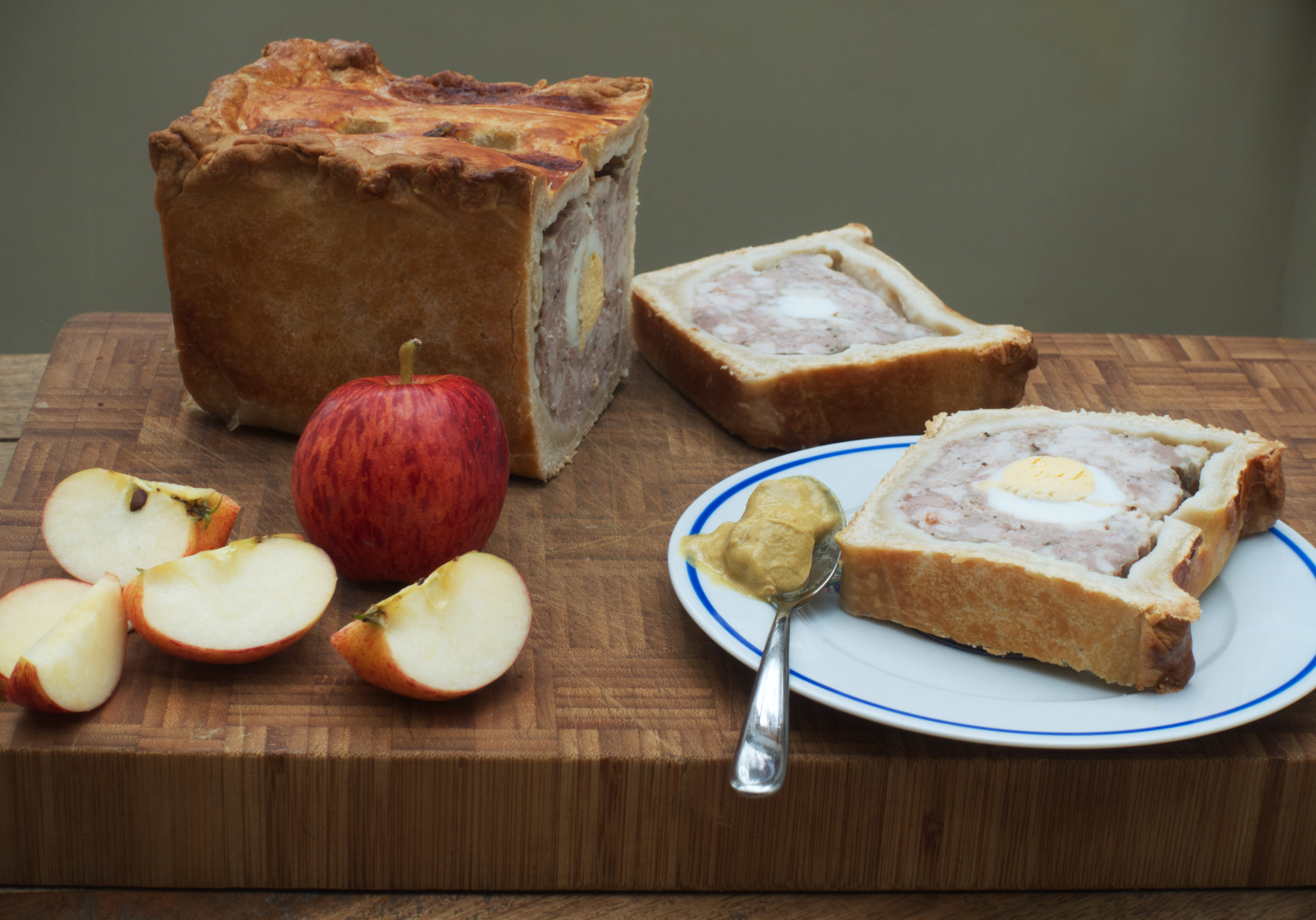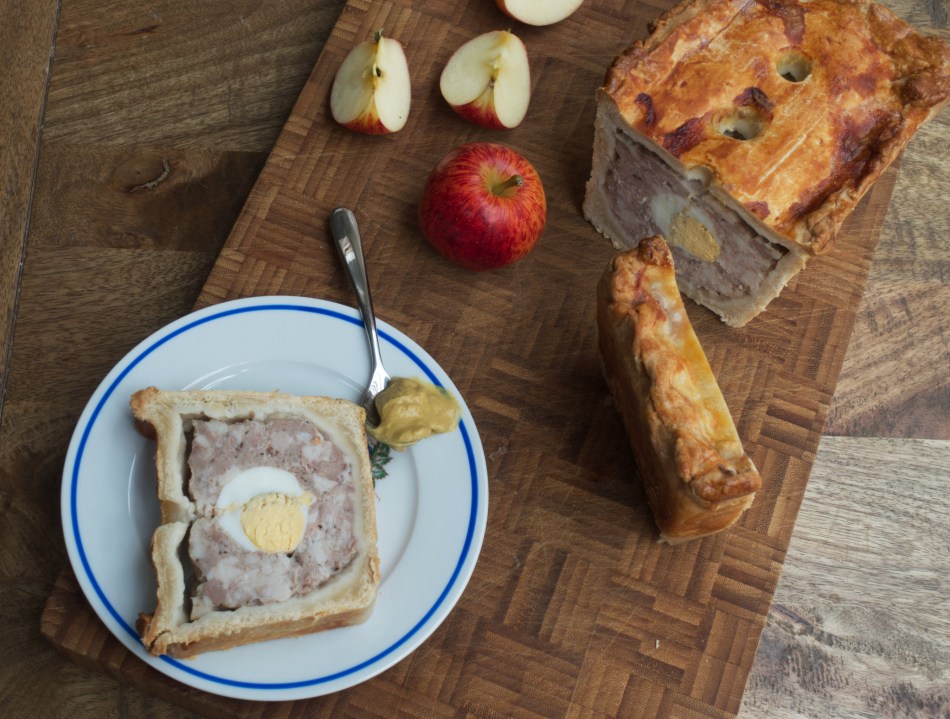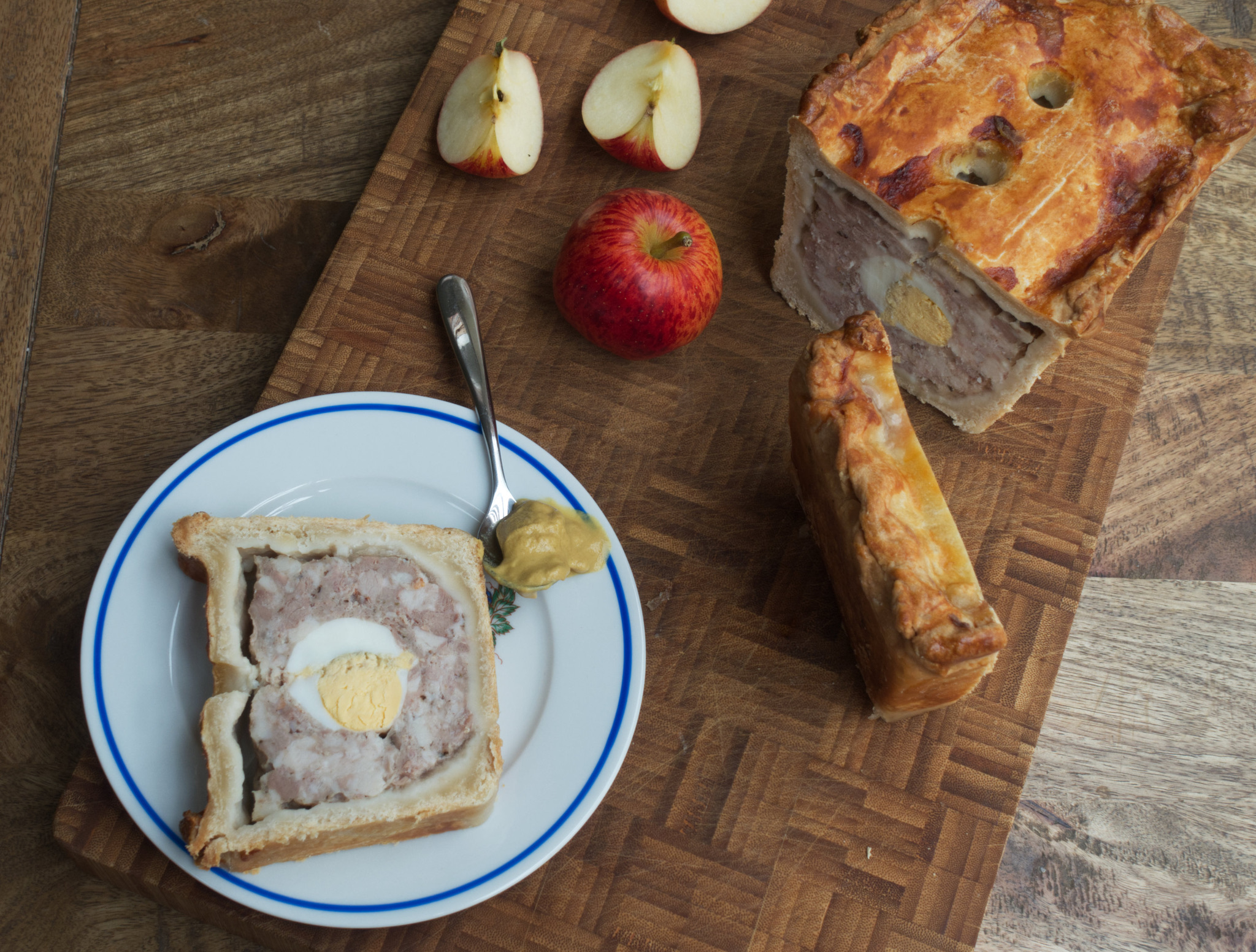Some dishes are just meant to be shared. I’m not talking about those items you buy on a hangover from the corner shop that sanctimoniously declare ‘meant for sharing’ or ‘share size’ on their passive aggressive packaging (I’ll be the judge of that, cheese and onion crisps and chocolate fingers). I mean something that you’ve invested energy and love into, something which demands to be passed around, praised and enjoyed; something impressive and delicious. A homemade cassoulet. A perfect chocolate cake. A batch of scones. A gala pie.
The moment of cutting into a gala pie, and revealing the perfect row of eggs suspended in meat minced by your own fair hands is one of serious culinary pride. It deserves an audience, and you deserve your moment in the sun.
A gala pie is a pork-based pie, with a row of hard-boiled eggs running straight through the centre. It traditionally uses hot water pastry, and can be round or rectangular. It comes out of the oven bronzed and beautiful, and you can decorate the top of the pie as much or as little as your heart desires. It will cut into handsome slices, each showing off the egg cross-section. Commercial producers of gala pies have an egg-based advantage: eggs are separated before creating a sausage of yolks which is poached, before being placed in a sausage of whites, creating a perfectly even egg cylinder. But you can create a similar effect simply by slicing off the ends of the eggs before placing them in the pie.
There are a hundred different ways to create the pork base; I use a mixture of sausage meat, pork belly and smoked bacon rashers. The bacon and pork belly are hand chopped, which brings a fantastic texture to the finished pie; it might feel like a slightly repetitive job, but it’s also a satisfying one, and certainly worth it over, say, using pork mince.
Hot water crust pastry isn’t terribly common now, but it’s a really great pastry to work with. You don’t need to worry about overworking it like you do with shortcrust pastry; really, with hot water crust, you can treat it more like a playdough, moulding it against the sides of your tin, building it up, patching if necessary, until you have the desired shape. The two keys to good hot water crust are, first, take your time to press the pastry into the corners and base of the tin, keeping it even: this will ensure nice, crisp sides when you demould it, and even cooking. And, secondly, be vigilant for holes or cracks: your patching can be as haphazard as you like, but make sure that your hard work isn’t going to seep through the pastry into the bottom of your tin and cause it to stick.
Thanks to the eggs, the contents of this pie doesn’t shrink as much as, say, a pork pie. Because of this, you can get away without using jelly to fill the crevices. Often, I am grateful for this: jelly needs to be added when the pie is cooled, and then left to cool itself. Sometimes this is one step of delayed gratification too far for me. But, that said, some people are a sucker for jelly, and I do have a soft spot for it. So, if you want to add jelly to the pie, leave the pie until it is completely cold, but don’t demould it. Soak a single platinum-strength gelatine leaf in cold water, and heat up 150ml good chicken stock to steaming. Squeeze out the soaked, softened gelatine, and add to the stock, stirring until it dissolves. Then, using a funnel, slowly pour the jelly stock into the vent holes. Let each addition soak into the pie before adding a little more. Leave to cool again, before slicing the pie.

Gala pie
The moment of cutting into a gala pie, and revealing the perfect row of eggs suspended in meat minced by your own fair hands is one of serious culinary pride
Makes: 1 large pie
Takes: 2 hours, plus cooling
Bakes: 1 hour 30 minutes
For the pastry
90g lard
60g butter
550g strong white flour
200 ml water
1 teaspoon salt
1 egg yolk
For the filling
300g pork shoulder
150g smoked streaky bacon
300g pork sausages
½ teaspoon dried sage
¼ teaspoon ground white pepper
4 large eggs
- Line a 2lb loaf tin with a single strip of baking paper, which overhangs the sides to assist you in demoulding the tin later on.
- Remove any skin from the pork shoulder, and dice the meat into 5mm squares; snip the bacon to a similar size. Skin the sausages and, using your hands, combine with the diced pork and bacon. Season the mixture with the dried sage and white pepper. Fry off a very small amount of the sausage and taste it, then adjust the salt in the raw mix according to your taste. Refrigerate until you’re ready to use.
- Place the eggs in a large pan of cold water, bring up to a boil, and cook for 5 minutes. Immediately remove the pan from the heat, and run cold water over the eggs until they remain cold to the touch. Peel the eggs, and slice the ends off to expose the yolks.
- To make the pastry, rub together the flour and butter until it resembles breadcrumbs. Heat together the water, salt, and lard until it reaches a boil. Remove from the heat and beat this into the flour mixture with a wooden spoon.
- When the dough is cool enough, use your hands to bring it together into a ball of smooth, even dough. Press the dough out onto a plate and cover with clingfilm, and leave it to cool for ten minutes.
- Preheat the oven to 200°C. Lightly flour a work surface, and roll ¾ of the pastry out into a rough rectangle, large enough to cover the inside of your tin. Roll the pastry up onto a rolling pin and lower into the tin: adjust and press the pastry into the tin, making sure it is flush against the corners and sides, leaving a little overhang over the top of the tin.
- Place half of the meat mixture into the tin. Create a channel in the centre for the eggs, and place them end to end. Place the rest of the meat in the tin, fitting it around the eggs.
- Roll out the remaining pastry into a rectangle the size of the top of your tin. Beat the egg yolk with a fork, and dab the overhanging pastry in the tin with the yolk. Place the pastry on top, and crimp the pastry where it meets. Use a chopstick or sharp knife to create three generous steam holes along the centre of the pie; don’t dig down deeply enough to pierce the eggs. Brush the top of the pie with egg yolk.
- Bake for 30 minutes, then drop the temperature to 180°C and cook for another 90 minutes. Leave to cool before easing the pie out of the tin, using the baking paper handles to aid you.







Comments